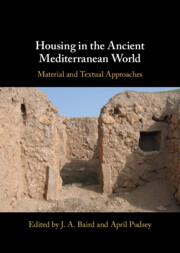Book contents
- Housing in the Ancient Mediterranean World
- Housing in the Ancient Mediterranean World
- Copyright page
- Contents
- Figures
- Tables
- Contributors
- Acknowledgements
- Introduction
- 1 Kinship ‘In the Halls’
- 2 Domesticating the Ancient House
- 3 Mind the Gap
- 4 A Family Affair
- 5 Textiles in Alkestis’ thalamos
- 6 Architectural Rhetoric and the Rhetoric of Architecture
- 7 The Reconstruction of an Agricultural Landscape
- 8 Mudbricks and Papyri from the Desert Sand
- 9 Housing and Community
- 10 The Elusive vestibulum
- 11 Living in the Liminal
- 12 Experiencing Sense, Place and Space in the Roman Villa
- 13 Houses and Time
- 14 Spaces of Desire
- 15 A Response: ‘Using the Material and Written Sources’ Revisited
- Index
- References
12 - Experiencing Sense, Place and Space in the Roman Villa
Published online by Cambridge University Press: 08 July 2022
- Housing in the Ancient Mediterranean World
- Housing in the Ancient Mediterranean World
- Copyright page
- Contents
- Figures
- Tables
- Contributors
- Acknowledgements
- Introduction
- 1 Kinship ‘In the Halls’
- 2 Domesticating the Ancient House
- 3 Mind the Gap
- 4 A Family Affair
- 5 Textiles in Alkestis’ thalamos
- 6 Architectural Rhetoric and the Rhetoric of Architecture
- 7 The Reconstruction of an Agricultural Landscape
- 8 Mudbricks and Papyri from the Desert Sand
- 9 Housing and Community
- 10 The Elusive vestibulum
- 11 Living in the Liminal
- 12 Experiencing Sense, Place and Space in the Roman Villa
- 13 Houses and Time
- 14 Spaces of Desire
- 15 A Response: ‘Using the Material and Written Sources’ Revisited
- Index
- References
Summary
Philosophical studies of the interpretation of sensory information have emphasized the central role of senses in the body’s experience of the world as well as highlighting the plurality and overlap in one’s sensory responses to it. This chapter investigates how far such concepts of experiencing space through a multisensory lens are valid for the ancient Roman villa residences of mainland Italy. Sensory responses to the Roman house have previously been restricted to examining sightlines within and outside the house, as well as movement and access within it. When we consider Pliny’s descriptions of his villas, Vitruvius’ guidance on developing a villa, or Seneca’s description of Scipio’s villa, however, it becomes clear that these residences could affect numerous sensorial responses. As such, foregrounding vision and movement above other senses experienced in the Roman domestic realm risks providing only a partial understanding of life in these residences. This chapter proposes the application of further theoretical frameworks, such as soundscapes and smellscapes, for studying the villa.
- Type
- Chapter
- Information
- Housing in the Ancient Mediterranean WorldMaterial and Textual Approaches, pp. 381 - 411Publisher: Cambridge University PressPrint publication year: 2022



